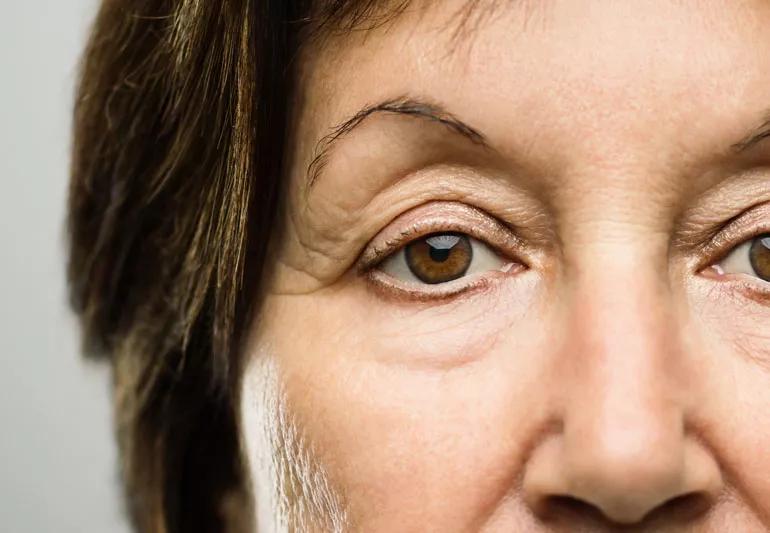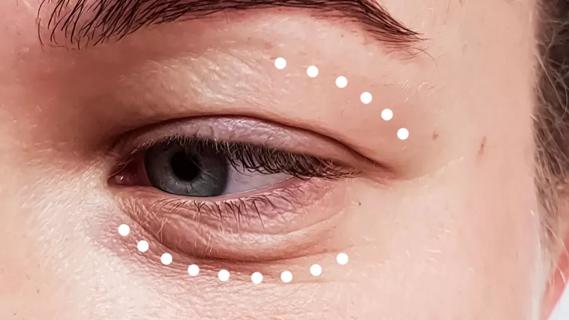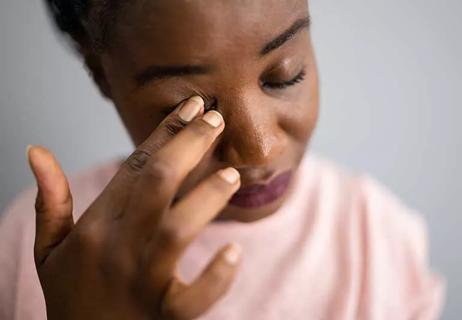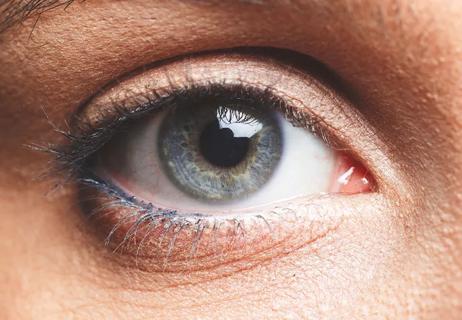Injections or surgeries can give aging eyes a lift

As you age, your skin gradually loses its elasticity and begins drooping. This sagging effect is most obvious on your face, especially in the areas around your eyes.
Advertisement
Cleveland Clinic is a non-profit academic medical center. Advertising on our site helps support our mission. We do not endorse non-Cleveland Clinic products or services. Policy
In fact, it can often look like you have a droopy eyelid. “The term ‘droopy eyelid’ has a multitude of meanings,” says ophthalmologist and oculoplastic surgeon Julian Perry, MD. “It can be a droopy brow. In other cases, the lid is actually low. With other people, it can even be the skin in between these two things. They’re noticing that extra folding of skin.”
Determining the source and severity of a droopy eyelid is more complicated than you might think. “The first kind of drooping that we look at is the height of the eyelid,” says Dr. Perry. “And then the second kind that we look at is the height and position of the eyebrow. When people look in the mirror, a droopy eyebrow shows up and manifests itself as a full or heavy or droopy eyelid. Finally, we look at the skin that folds in between those two structures, in between the brow and the eyelids. We look at all three of those things.”
However, any bags and sags, as well as dark circles around the eyes, are related to aging skin.“The skin around the eyelids is some of the thinnest skin in our entire bodies, and it’s constantly moving,” says Dr. Perry. “It’s also exposed to the sun because it’s on our face. That combination of thin skin, constant movement with blinking, and exposure to the sun causes that particular area of skin to really stretch with time and gravity and age.”
Advertisement
Plus, as we age, our body composition also shifts. “Fat is a sign of youth,” says Dr. Perry. “If you think about a baby’s face, it’s chubby. And with age, we lose fat and we gain these hollows and we get skeleton eyes. That casts shadows and contours to our eyelids.”
As you age, several other factors contribute to a potentially undesirable look of the area around your eyes.
If you’re bothered by drooping eyelids and sagging skin, you’re not alone. More and more people are investigating cosmetic fixes to smooth out the wrinkled skin around your eyes. “Treatment for aging eyelids focuses on the particular anatomical change that’s causing the problem,” says Dr. Perry.
Doctors divide the options for correcting these issues into nonsurgical and surgical approaches.
Nonsurgical treatments — including hyaluronic acid fillers, or injections like Botox® or Dysport® — can help you look more youthful. These treatments can smooth out wrinkles around your eyes, fill in hollows or tighten sagging eyelids. An oculoplastic surgeon or oculofacial plastic surgeon can assess the best treatment for your needs.
Injection of products that contain botulinum toxins (such as Botox or Dysport) can help tighten sagging skin and reduce wrinkles around your eyes.
These products work to correct eyelid issues associated with aging by weakening muscles in the crow’s feet area around your eye, giving you a more youthful look when you smile, Dr. Perry says. “Interestingly, by weakening the muscles that pull the brows down, it can actually lift the brows,” says Dr. Perry. “We can achieve a Botox brow lift that can take some of those folds and heaviness of the upper lids and lift it out of the way.”
Advertisement
Hyaluronic acid gel fillers, which include products such as Juvéderm® and Sculptra®, provide extra volume to fill in deeper crevices on your cheeks and around your lower lid areas.
“I’ve used fillers in the lower eyelids for a decade, and it often improves the hollowness that can form beneath the bag within the eyelid,” Dr. Perry notes. “It’s not perfect, though. Fillers can cause a bluish hue in those hollow areas, which can contribute to the appearance of dark circles.”
Plus, fillers are also temporary, require reinjections over time and can cause fluid buildup in the eyelids. “We call this fluid buildup festoons or malar mounds,” says Dr. Perry. “Those are also unsightly because they lead to shadows and contours in the junction between the eyelid and the cheek.”
In more serious cases, fillers in the tear trough periorbital hollow can even cause blindness. “The risk of that is incredibly low — but it is not zero,” Dr. Perry says. “If the filler gets into a blood vessel that tracks behind the eye, bad things can happen to the vision. And it can be permanent.”
Dr. Perry adds that it’s often a good idea to use both fillers and injections. Because each option treats different problems, you experience greater overall benefit. “Both products have their pros and cons but do work well to provide a more youthful appearance.”
Advertisement
However, fillers aren’t right for everybody. “If you have fluid blisters, inflammation, allergies, Graves’ disease — anything that causes a tendency for fluid buildup in the eyelids — you may not be a good candidate,” he notes.
You can use chamomile tea bags to improve the tear film, the layers that keep your eyes moist. Chamomile tea bags can also improve blepharitis, which is “basically dandruff, thick oils and inflammation around the eyelashes,” says Dr. Perry. However, these tea bags are not helpful at improving dark circles.
“Surgical options offer a more permanent solution that can treat more of the components that contribute to the aging process,” says Dr. Perry. “The surgical options are designed to treat structural issues around the eyelids, such as crow’s feet or deeper crevices due to aging.”
Eyelid surgery — blepharoplasty and other procedures — can remove excess skin and fat, reposition fat and tighten your skin.
If you have excess skin, the surgeon can remove a small amount in your lower lids, but Dr. Perry says it’s important to realize that removing this skin doesn’t really treat the underlying problem of laxity and bags under your eye. This skin removal only treats part of the problem.
Advertisement
If you want a more dramatic, rejuvenating effect from surgery, you’ll need to undergo a deeper restructuring that treats the problem of excess fat and bags.
“Older surgeries involved simply removing this excess fat, which improves the undereye bag, but do nothing to improve the hollow area that forms beneath the bag,” Dr. Perry explains.
Fat removal can help you appear less tired and more alert, but can have a downside, he says. “You might think that removing the fat is the key to rejuvenation. In reality, removing the fat can sometimes add to aging changes and add to the hollows.”
For the hollow underneath eye bags, oculoplastic surgeons reposition the fat rather than removing it completely.
“Part of what we do with our cosmetic surgeries is use fat to our advantage to improve the shadows, hollows and the contours, rather than simply throwing it away,” Dr. Perry says. “Yes, those eyelid bags are made up of herniated fat. But it does not mean that we necessarily want to simply discard that fat.”
Taking fat from one area and repositioning it addresses both the bag and the hollow area underneath it. In fact, Dr. Perry says, this procedure treats dark circles and hollows better than hyaluronic acid fillers — but it requires a bigger commitment to surgery.
“When we move eye socket fat into the cheek, we’re crossing anatomic boundaries, which can result in longer healing time and little lumps and bumps that take some time to improve,” he says.
Unfortunately, no. Exercises don’t exist to prevent droopy eyelids or the effects of aging on your eyes.
“If you think about it, our eyelids are exercising all day long,” Dr. Perry says. “They blink 30,000 times a day. Our eyes are constantly moving. Our eyes are already getting a workout. There’s nothing extra we can do to prevent or delay or improve these aging changes.”
However, preventing inflammation near your eyes is important. “Rubbing your eyes can lead to skin stressing, which is maybe why long-term contact lens wear can cause droopy eyelids,” Dr. Perry says. “Anything that causes inflammation is going to hasten or aggravate aging changes.” That’s why it’s important to treat allergies, dry eye and blepharitis, and avoid the sun. “All of those are inflammatory and those participate in the aging process.”
Although droopy eyelids usually result in purely cosmetic issues, Dr. Perry says they can also sometimes cause vision problems. “Generally, it’s going to cause limited ability to see up above,” he explains. “Some people notice a shadow on the upper part of their vision. Some people notice that they’re needing to lift their brows up in order to see better, or even lift their eyelids up to see better.”
Other people might feel symptoms like fatigue, heaviness or weightiness, he adds. “And when the lower lid sags, that it can sometimes lead to tearing. That can affect vision as well.”
Generally, you should seek treatment if vision changes are having an impact on your daily activities. “That could mean affecting your ability to see, to drive, to read, to use a computer,” says Dr. Perry.
If facial changes are affecting your self-esteem, that’s also a valid reason to seek treatment, Dr. Perry adds. “If you’re not looking the way you feel — if you feel youthful, energetic and vibrant, and the mirror isn’t showing you that — that’s a reason to see a doctor.”
Your primary eye care doctor, especially one who has experience in oculoplastic surgeries, can be a good start if you have concerns. But if you do opt for surgery, be sure to have any procedures done by an oculoplastic surgeon or oculofacial plastic surgeon.
“There’s lots of doctors who perform cosmetic surgery around the face,” Dr. Perry says. “But when the eyes and vision are at stake, it makes sense to seek an expert in both vision and plastic surgery around the eyes. The two are intimately related.”
At a visit, you’ll receive a thorough examination to determine the source of visual issues that might be related to structure around your eyes, or cosmetic issues.
“First, we’ll ask you what type of symptoms you’re having,” Dr. Perry explains. “And then on examination, we’ll measure the position of your lids, brows and skin. Then we can do what’s called a field of vision test, which actually documents and demonstrates how much of the upper part of your vision is affected from various types of droops.”
From there, your doctor will look at your individual situation and discuss the best options for you. “We choose between these options after a careful assessment of your individual anatomy and desires,” Dr. Perry says. If you feel bothered by the way your eyes look as you age, there are solutions to make you look — and feel — more like yourself.
Learn more about our editorial process.
Advertisement

Many factors, like eyelid irritation, cosmetic lash procedures and underlying health conditions, can affect your eyelashes

Both chalazia and styes appear as bumps on your eyelid — but styes are typically painful

Keep your eyes clean and try to stay makeup- and contacts-free to help move healing along

The procedures take different approaches to eliminate saggy, baggy skin around your eyes

Doing so can cause a severe infection, damage to your eyelid or even a corneal abrasion

This glaucoma drug can also thicken lashes, just note side effects

Pink eye usually refers to infectious conjunctivitis, which can look similar to allergies or other infections and eye conditions

Nocturnal lagophthalmos may be caused by damaged nerves or muscles in your face

The best parenting style balances enforcing rules and showing plenty of love

Tips include cutting back on sugar, focusing on exercise and managing stress

It can be harder to let go when you’ve invested time, energy and emotions — but it might be the healthier choice long term